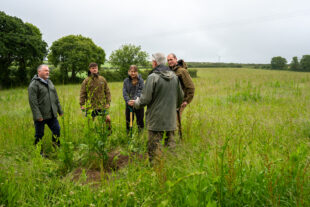https://defrafarming.blog.gov.uk/make-field-dried-hay-or-haylage/
Make field-dried hay or haylage
The guidance on this page is for SFI pilot participants only. Please visit GOV.UK for the official Sustainable Farming Incentive scheme guidance.
Find out how land managers can use haymaking and aftermath grazing to maintain species-rich grassland.
If you’re completing this action as part of the Sustainable Farming Incentive pilot, how you do it is up to you.
The advice on this page can help you get better environmental and business benefits, but you do not have to follow it to get paid.
About haymaking
You can use haymaking to help maintain species diversity in meadows.
Hay is cut annually, followed by a period of shutting up the meadow before aftermath grazing.
As hay is turned, tedded and dried on the field, wildflower seed can return to the meadow. This helps to retain or reintroduce a wider range of species.
You can make field dried hay on any type of grassland on flat or gently sloping ground. Haymaking is best suited to:
- land receiving no or low inputs of nutrients
- species-rich grassland
If your land is part of a Site of Special Scientific Interest (SSSI), you must find out whether you need consent to manage your hay meadow before you start.
Benefits of making field-dried hay
By making hay, you can:
- reduce fertiliser costs compared to making silage
- produce good quality winter forage for livestock
Benefits to the environment include:
- healthier, carbon-rich soils
- better conditions for a large number and range of wildflowers, including rare species
- more food, nesting and shelter for insects, birds, bats and small mammals
- improved water quality
- the cultural value of a traditional landscape
How to make field-dried hay
Birds, nests and eggs are protected by law. You must check the site before any field work. If you see signs of nesting birds, delay work until birds fledge.
Cut hay
‘Shut up’ meadows by removing all livestock no later than mid May. Cut the meadow no earlier than late June, or mid July in upland areas where grass growth is slower. You can cut later if the weather is wet. Try to avoid repeated late cuts as it will decrease the number of wildflower species.
If wet weather means you cannot make hay, you can make haylage. Make sure the swath is wilted and turned over before wrapping to allow some wildflower seeds to return to the meadow.
Ideally leave unmown strips at least 2 metres wide around the edge of the field to provide refuge for displaced wildlife. You can do this on rotation.
You can aftermath graze the field edges to stop them becoming rank. If grazing is not possible, instead take a second cut in late summer or early autumn and remove the cuttings.
Managing hay meadows
Graze with livestock
Grassland will have a consistent sward height and structure if you manage by cutting alone. You can use aftermath grazing to add variety to the sward and improve hay meadow biodiversity. Graze with cattle to help maintain a range of vegetation heights.
Grazing provides:
- late summer forage
- more nutrients for fields
- better germination as livestock trample seeds into the soil
- conditions for less vigorous species to compete with more competitive grasses
Graze from late summer until autumn. This will normally start around 6 weeks after cutting. Exact timings will depend on the growing season and ground conditions at different sites.
You can also graze during the following spring, unless your meadow has early flowering plants like cowslips and bluebells.
Remove livestock when the average sward height falls below 5cm and when the ground is too wet. This will help prevent damage from poaching.
Do not feed livestock during grazing periods, unless essential for animal health.
Find out how to manage livestock to protect wildlife habitats.
Use fertiliser
Haymaking removes nutrients from the field. Soil phosphate (P) levels need to be at index 1 or less where species rich meadows are the aim.
Dung from grazing livestock will help return some nutrients to the soil. You should regularly sample and test the soil nutrient status. Use well-rotted farmyard manure to replace nutrients lost by cutting and removing hay or haylage.
Apply no more than 12 tonnes per hectare of manure in a single year. To maintain the variety of wildflowers in species-rich grassland, apply manure only every second or third year. Do not increase inputs above your current levels.
Do not apply too much manure as high nutrient levels will cause grasses to dominate and wildflowers will be lost over time.
Apply manure in spring to minimise nutrient losses and the risk of water pollution.
You must follow the farming rules for water. These require you to take steps to stop manure, fertiliser or soil getting into water bodies.
Follow good practice guidance when you apply fertiliser.
Control weeds
Annual cutting means meadows tend to have fewer issues with weeds. Find out how to reduce and manage weeds in your meadow.



